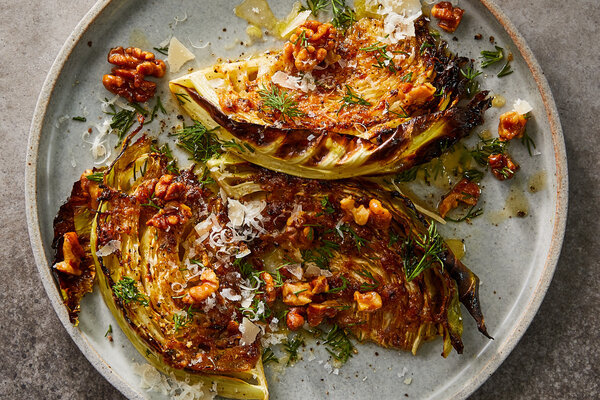Roasted cabbage is an underrated and underappreciated vegetable. When roasted, it becomes sweet, tender, and full of flavor. It’s the perfect side dish for any meal, and it’s packed with nutrients and has many health benefits.
Cabbage has been a staple food for centuries, and it has been enjoyed in many different cultures and cuisine. Its a member of the cruciferous vegetable family, along with broccoli, cauliflower, and Brussels sprouts.
It’s low in calories and high in fiber, making it a great choice for a healthy diet. Its mild flavor and versatility make it a perfect addition to any meal. Here are list of what we would be covering in this article;
- How to make roasted cabbage
- How to store roasted cabbage
- How to choose the best cabbage for roasting
- How long to roast a cabbage
- How to add roasted cabbage to your meal
- How to identify spoilt roasted cabbage
- Health benefits of roasted cabbage
HOW TO MAKE ROASTED CABBAGE
Roasting cabbage is a simple and easy way to prepare this nutritious and flavorful vegetable. All you need is a head of cabbage, oil, salt, and pepper.
You can add other seasonings, such as garlic, herbs, or lemon juice, making it even more delicious. The key to making perfect roasted cabbage is to start with high-quality ingredients and follow simple steps.
Let’s get started!
Ingredients:
- 1 Head of cabbage
- 1 Tablespoon of olive oil
- Salt
- Pepper
- Any additional seasonings (optional)
Procedures:
- First, preheat your oven to 400 degrees Fahrenheit. Then prepare the cabbage by cutting it into wedges.
- Next, place the cabbage on a baking sheet and drizzle it with olive oil. (make sure to coat the cabbage evenly with oil).
- Sprinkle the salt, pepper, and any seasonings you like (optional) on top of the cabbage.
- Once the oven is preheated, place the baking sheet with the seasoned cabbage in the oven. Roast the cabbage for about 20 minutes or until tender and the edges are slightly browned. If you want the cabbage to be a bit crispier, roast the cabbage for another 5 to 10 minutes.
- Serve as a side dish or use it in different dishes.
HOW TO STORE ROASTED CABBAGE
It’s important to understand the science behind why proper storage is so important. Cabbage is a highly perishable vegetable and spoils quickly if not stored properly. Bacteria can grow rapidly on cabbage, especially when stored at room temperature.
Storing cabbage in a fridge is essential because it prevents it from spoiling and can last up to 3 days. To prevent your roasted cabbage from spoiling, start by choosing a clean, airtight container or a resealable bag large enough to hold the cabbage. Make sure the container or bag is dry and free of any moisture. Once the container or bag is ready, place the roasted cabbage inside and seal tightly.
Store the container or bag in the fridge and place it on a shelf farther away from the door. The reason is that the temperature near the door is not consistent with the temperature in the middle of the fridge. So, to keep the cabbage as fresh as possible, it’s best to store it in a more stable environment.
Read Also:
HOW TO CHOOSE THE BEST CABBAGE FOR ROASTING
Choosing the best cabbage for roasting is important to ensure a delicious and nutritious result. With knowledge of what to look for, you can easily find the perfect cabbage for roasting. The first thing to consider when choosing cabbage for roasting is the size of the cabbage.
The ideal size for a cabbage roasted is about 2 to 3 pounds. The reason is that a large cabbage can be difficult to cook evenly, while a small cabbage may not have enough flavor. So, a 2 to 3-pound cabbage is the perfect size for roasting.
Next is the type of cabbage. There are many different types of cabbage, such as green cabbage, red cabbage, savoy cabbage, and napa cabbage. But when roasting cabbages, green cabbage is often the best choice. It has a firm texture that holds up well to high heat and has a slightly sweet and nutty flavor that’s perfect for roasting.
Read Also:
HOW LONG TO ROAST A CABBAGE
The length of time to roast a cabbage depends on several factors, including the temperature of the oven, the size, and the desired level of doneness of the cabbage. To ensure that your cabbage is cooked to perfection, you should consider all these factors:
- A 2 to 3-pound cabbage will take about 30 to 45 minutes to roast, while a large cabbage may take up to an hour or more. If you’re using a small cabbage, check it after 20 to 25 minutes to ensure it doesn’t overcook.
- Next is the temperature of the oven. For the best results, preheat your oven to 400 degrees Fahrenheit.
- For a tender and flavorful cabbage, roast it until the edges are browned and slightly crispy and the center is soft.
- To test for doneness, insert a fork or knife into the center of the cabbage. If the fork or knife slides in easily, the cabbage is ready.
HOW TO ADD ROASTED CABBAGE TO YOUR MEAL
It’s important to note that roasted cabbage is a versatile ingredient used in different dishes. It’s also a great way to add vegetables to your diet and is relatively easy to prepare. Roasted cabbage can be used as a side dish, a topping, or even as the main ingredient in a dish.
One of the easiest ways to add roasted cabbage to a meal is to simply roast a head of cabbage and serve it alongside another dish. For example, you could roast a head of cabbage and serve it alongside grilled chicken or fish.
Another option is to add roasted cabbage to a salad. Roasted cabbage is also delicious in soups and stews and used as a topping for pizza or pasta dishes.
Another easy and popular way to add roasted cabbage to a meal is to make roasted cabbage “faux-tato” salad.
HOW TO IDENTIFY SPOILT ROASTED CABBAGE
When identifying spoilt roasted cabbages, there are five signs to look for.
- The first thing is a change of color. Roasted cabbage should be a deep, rich green color. If it starts to turn yellow or brown, it’s likely gone bad.
- The second sign is a change in texture. Roasted cabbage should be firm and slightly crunchy. If it’s starting to get mushy or soft, it’s likely past its prime.
- The third sign is the smell. Freshly roasted cabbage should have a slightly sweet and nutty fragrance. If it smells sour or unpleasant, it’s probably gone bad.
- The fourth sign is the change of taste. Freshly roasted cabbage should have a mild, sweet flavor. If it tastes bitter or unappealing, then it’s likely not safe to eat.
- The fifth sign is the change of surface. If the roasted cabbage is slimy or moldy, it’s best to discard it.
HEALTH BENEFIT
- Roasted cabbage helps to reduce inflammation, improves heart health, supports weight loss, boosts the immune system, and protects against some types of cancer.
- Roasted cabbage is a good source of plant-based protein, making it a great choice for vegans and vegetarians.
- Roasted cabbage improves gut health, better blood sugar control, and reduces the risk of certain chronic diseases
- Roasted cabbage has antioxidant content that helps protect the body from damage caused by free radicals. Free radicals are unstable molecules that can damage cells and cause inflammation.
- The antioxidants in roasted cabbage help protect against diseases like heart disease, cancer, and Alzheimer’s.
Conclusion:
Roasted cabbage is a healthy and delicious option for anyone looking to add more vegetables to their diet. With simple preparation and versatile uses, roasted cabbage is a perfect dish for any occasion. With no time spent and a few ingredients, you can have a flavorful and nutritious side dish or ingredient for other recipes.
So, next time you’re looking for a nutritious and tasty side dish, consider giving roasted cabbage a try. What’s your favorite way to enjoy roasted cabbage? And would you consider adding roasted cabbage to your weekly meal plan? Let us know in the comment section below.



